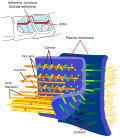Adherens junction
Cell–cell junctions that connect the actin cytoskeleton of adjacent cells
Adherens junctions are a type of cell junction that play a crucial role in maintaining the structural integrity of tissues by connecting the actin cytoskeleton of adjacent cells. These junctions are essential for the formation and maintenance of tissues and are involved in various cellular processes, including cell signaling, cell adhesion, and tissue morphogenesis.
Structure[edit]
Adherens junctions are composed of cadherins, which are transmembrane proteins that mediate cell-cell adhesion. The extracellular domains of cadherins from adjacent cells interact in a calcium-dependent manner, forming a strong adhesive bond. The intracellular domains of cadherins are linked to the actin cytoskeleton through a complex of proteins, including catenins such as _-catenin, _-catenin, and p120-catenin.
Cadherins[edit]
Cadherins are a family of transmembrane proteins that are critical for the function of adherens junctions. They are characterized by their ability to bind calcium ions, which is necessary for their adhesive function. Different types of cadherins, such as E-cadherin, N-cadherin, and P-cadherin, are expressed in different tissues and contribute to tissue-specific adhesion properties.
Catenins[edit]
Catenins are cytoplasmic proteins that link cadherins to the actin cytoskeleton. _-catenin binds directly to the cytoplasmic domain of cadherins, while _-catenin connects _-catenin to actin filaments. p120-catenin regulates the stability and turnover of cadherins at the cell membrane.
Function[edit]
Adherens junctions are involved in several key functions:
- Cell adhesion: They provide strong adhesive contacts between cells, which is essential for the maintenance of tissue architecture.
- Signal transduction: Adherens junctions participate in signaling pathways that regulate cell behavior, including cell proliferation, differentiation, and migration.
- Tissue morphogenesis: During development, adherens junctions play a role in the shaping and organization of tissues by coordinating cell movements and rearrangements.
Role in Disease[edit]
Dysfunction of adherens junctions is implicated in various diseases, including cancer. Loss of E-cadherin function, for example, is associated with increased tumor invasiveness and metastasis. Additionally, mutations in catenin genes can lead to developmental disorders and contribute to the progression of certain cancers.
Related pages[edit]
Gallery[edit]
-
Diagram of adherens junctions showing structural proteins
Ad. Transform your life with W8MD's Budget GLP-1 injections from $75


W8MD offers a medical weight loss program to lose weight in Philadelphia. Our physician-supervised medical weight loss provides:
- Weight loss injections in NYC (generic and brand names):
- Zepbound / Mounjaro, Wegovy / Ozempic, Saxenda
- Most insurances accepted or discounted self-pay rates. We will obtain insurance prior authorizations if needed.
- Generic GLP1 weight loss injections from $75 for the starting dose.
- Also offer prescription weight loss medications including Phentermine, Qsymia, Diethylpropion, Contrave etc.
NYC weight loss doctor appointmentsNYC weight loss doctor appointments
Start your NYC weight loss journey today at our NYC medical weight loss and Philadelphia medical weight loss clinics.
- Call 718-946-5500 to lose weight in NYC or for medical weight loss in Philadelphia 215-676-2334.
- Tags:NYC medical weight loss, Philadelphia lose weight Zepbound NYC, Budget GLP1 weight loss injections, Wegovy Philadelphia, Wegovy NYC, Philadelphia medical weight loss, Brookly weight loss and Wegovy NYC
|
WikiMD's Wellness Encyclopedia |
| Let Food Be Thy Medicine Medicine Thy Food - Hippocrates |
Medical Disclaimer: WikiMD is not a substitute for professional medical advice. The information on WikiMD is provided as an information resource only, may be incorrect, outdated or misleading, and is not to be used or relied on for any diagnostic or treatment purposes. Please consult your health care provider before making any healthcare decisions or for guidance about a specific medical condition. WikiMD expressly disclaims responsibility, and shall have no liability, for any damages, loss, injury, or liability whatsoever suffered as a result of your reliance on the information contained in this site. By visiting this site you agree to the foregoing terms and conditions, which may from time to time be changed or supplemented by WikiMD. If you do not agree to the foregoing terms and conditions, you should not enter or use this site. See full disclaimer.
Credits:Most images are courtesy of Wikimedia commons, and templates, categories Wikipedia, licensed under CC BY SA or similar.
Translate this page: - East Asian
中文,
日本,
한국어,
South Asian
हिन्दी,
தமிழ்,
తెలుగు,
Urdu,
ಕನ್ನಡ,
Southeast Asian
Indonesian,
Vietnamese,
Thai,
မြန်မာဘာသာ,
বাংলা
European
español,
Deutsch,
français,
Greek,
português do Brasil,
polski,
română,
русский,
Nederlands,
norsk,
svenska,
suomi,
Italian
Middle Eastern & African
عربى,
Turkish,
Persian,
Hebrew,
Afrikaans,
isiZulu,
Kiswahili,
Other
Bulgarian,
Hungarian,
Czech,
Swedish,
മലയാളം,
मराठी,
ਪੰਜਾਬੀ,
ગુજરાતી,
Portuguese,
Ukrainian
